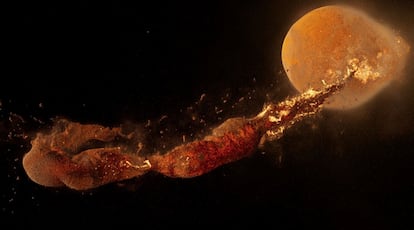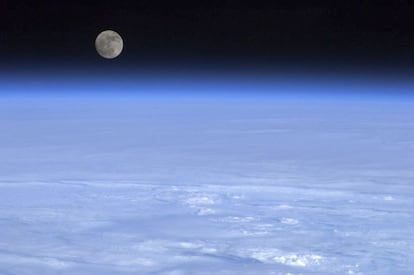The day the Earth got itself a Moon
Despite its proximity and having been the focus of many exploration missions, there are still many unanswered questions regarding its process of formation

The Moon has not always been with us. As unbelievable as it sounds, there was a time when our satellite was not part of Earth’s night sky view. Of course, that was so long ago that there were no humans around to not see it.
Since the late 1970s we know that the Moon was not born at the same time as the Earth; it is actually between 30 and 200 million years younger than the rest of the similar material that we know in the solar system. This is part of the information obtained from the analysis of the collection of lunar rocks brought to our planet mainly by the Apollo missions.
Our planet was formed 4.5 billion years ago. It originated from the material of the disk of gas and rocks that appeared as a result of the formation of the Sun. The analysis of the chemical composition of the lunar rocks allowed us to determine that the formation of our satellite came about at a later date, but we are still not entirely clear how it got there; this despite it being our closest astronomical object and having been the focus of numerous exploration missions, including the only manned ones to another celestial body.

The currently accepted theory about the origin of the Moon involves a literal planetary collision. When the Earth was young, it was hit by a planet the size of Mars (we even named it: “Theia”). The impact caused the formation of a debris disk from which a heavy moon could be formed, with a small iron core and the angular momentum restrictions (distances and rotation speeds) of the Earth-Moon system that we know.
However, although almost all the available data fits into this model, a few details do not, and therein lies the problem of the formation of our satellite in these collision models. The dilemma continues to be raised by the chemical composition obtained from lunar rocks: in most of the impact parameters that fit the rest of the measurements, the result is that the Moon would be composed mainly of material from Theia, the planet that hit Earth.
They say Rome wasn't built in a day, but the Moon? New simulations reveal a collision may have formed the Moon in only hours. As we better understand how the Moon evolved, a new study from @NASAAmes opens up a whole new range of possible starting places. https://t.co/GqK5o7xFf7 pic.twitter.com/MMSwV3jCJe
— Jim Free (@JimFree) October 11, 2022
In many isotopes, the chemical composition of the lunar mantle is identical to that of Earth, and it is highly unlikely – and this is the key – that the planet responsible for the cosmic collision had the same composition as the proto-Earth, as no two bodies in the solar system are the same unless they were formed in the same place. To solve this problem, different versions of the impact model have been explored. For example, using extreme parameters such as high collision speeds, or alternative versions with multiple impacts that would form smaller, intermediate moons, which would later combine to make the one we have now. The thing is that when one observable is adjusted, another one stops working. Thus, we are not entirely clear how the closest astronomical object to us was formed.
Hence the merit of the recent models that explain the formation of our satellite in just a few hours. The key is that computer simulations have been carried out with a resolution up to 1,000 times higher than the standard to date and using a technique known as smoothed-particle hydrodynamics. The models, which move hundreds of millions of particles and attempt to simulate 8.5-mile-sized chunks of moon, allow testing different impact angles, speeds, planet spins and sizes. The increase in the computing power of large computers makes it possible to detect behaviors that were not seen in previous simulations, or that used to be mistaken for numerical problems in the models.
The result is that Theia’s giant impact with Earth, rather than forming a debris disk, places a satellite of similar mass and iron content to our own in a wide, stable orbit. In this case the chemical composition is not a problem, because satellites with cooler interiors are formed, but with molten surfaces made mostly of proto-Earth material. This explains why the lunar mantle is very similar to that of the Earth, with such a thin surface layer, and also opens the door to new models that allow us to understand why the Moon’s axis of rotation is slightly tilted.
In this case, the improved models and a greater computing power make it possible to understand and simplify a crucial moment in the evolution of the Earth: the gigantic impact that gave rise to the formation of the Moon. But understanding the composition of the Moon is not easy, in part because all our knowledge is based on a small collection of rocks from a tiny area near the Moon’s equator and a sample from its far side. The Artemis missions, which will explore other regions and include samples taken from the depths of the Moon, may soon tell us a different story.
Tu suscripción se está usando en otro dispositivo
¿Quieres añadir otro usuario a tu suscripción?
Si continúas leyendo en este dispositivo, no se podrá leer en el otro.
FlechaTu suscripción se está usando en otro dispositivo y solo puedes acceder a EL PAÍS desde un dispositivo a la vez.
Si quieres compartir tu cuenta, cambia tu suscripción a la modalidad Premium, así podrás añadir otro usuario. Cada uno accederá con su propia cuenta de email, lo que os permitirá personalizar vuestra experiencia en EL PAÍS.
¿Tienes una suscripción de empresa? Accede aquí para contratar más cuentas.
En el caso de no saber quién está usando tu cuenta, te recomendamos cambiar tu contraseña aquí.
Si decides continuar compartiendo tu cuenta, este mensaje se mostrará en tu dispositivo y en el de la otra persona que está usando tu cuenta de forma indefinida, afectando a tu experiencia de lectura. Puedes consultar aquí los términos y condiciones de la suscripción digital.
More information
Últimas noticias
Most viewed
- Why we lost the habit of sleeping in two segments and how that changed our sense of time
- Charles Dubouloz, mountaineering star, retires at 36 with a farewell tour inspired by Walter Bonatti
- Venezuela faces its most tense Christmas yet
- CBS in crisis after pulling a report on Trump’s deportations to El Salvador (which later leaked online)
- Bukele clan fumes over investigation exposing their new wealth










































